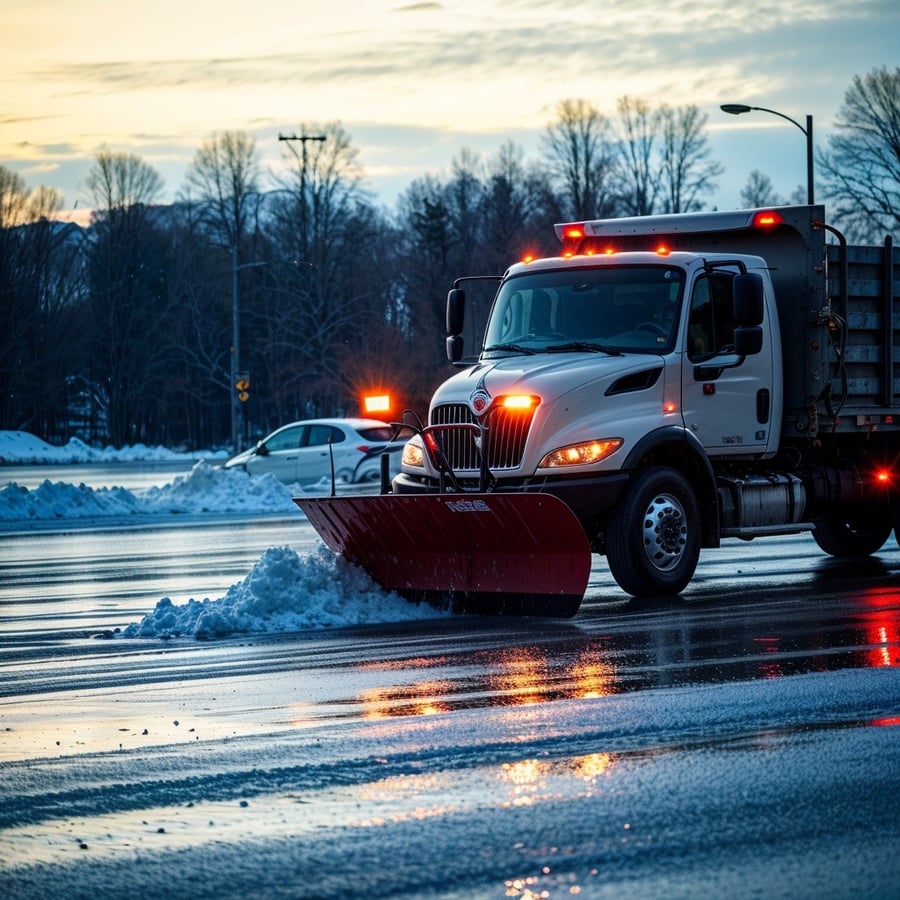Mastering Snow Removal: Essential Equipment and Techniques for Pros

Introduction: The Evolution of Professional Snow Management
After 25 years in the landscape and property management industry, I've witnessed firsthand how snow removal has transformed from simple plowing to a sophisticated, multi-faceted operation. Today's commercial snow removal demands a strategic approach combining advanced equipment, precise techniques, and careful planning to ensure property safety and accessibility during winter months.
Throughout my career managing snow removal operations across Long Island's most demanding commercial properties and luxury communities, I've learned that successful winter management isn't just about having the right equipment – it's about knowing exactly how and when to use it. In this comprehensive guide, I'll share my expertise on professional snow removal equipment and techniques that have proven effective across countless winter storms.
Essential Snow Removal Equipment for Commercial Properties
Primary Snow Removal Equipment
- Snow Plows and Trucks: The backbone of any commercial snow removal operation. I've found that hydraulic plows mounted on heavy-duty trucks offer the most versatility for large commercial properties. They excel at clearing parking lots and wide driveways efficiently, especially when equipped with wings that can increase the plow width by up to 30%. The key is selecting the right plow size - too large can damage property features, while too small increases operation time significantly.
- Salt/Sand Spreaders: Modern spreaders have revolutionized ice management with precise material control. Vehicle-mounted spreaders with automatic calibration systems help prevent over-salting while ensuring adequate coverage. I particularly recommend dual-purpose spreaders that can handle both salt and sand mixtures, giving you flexibility based on temperature conditions and property requirements.
- Snow Blowers: Commercial-grade snow blowers are essential for detailed clearing work. Two-stage blowers with serrated augers can handle both light powder and heavy, wet snow effectively. They're particularly valuable for clearing sidewalks, entryways, and other areas where plows can't access. I always ensure our fleet includes both walk-behind and ride-on models for maximum versatility.
Specialized Equipment
- Skid Steers with Snow Attachments: These versatile machines become invaluable during heavy snowfall events. With the right attachments - from pushers to snow buckets - a skid steer can handle everything from precise snow relocation to creating emergency access paths. They're particularly effective in tight spaces where traditional plows struggle to maneuver.
- De-icing Systems: Modern de-icing equipment has come a long way from simple salt spreaders. I've implemented sophisticated brine application systems that can pre-treat surfaces before storms, significantly reducing ice formation. These systems use less material while providing better coverage, making them both environmentally and economically beneficial.
- Snow Pushers: Also known as containment plows, these wide blade attachments are essential for clearing large commercial lots efficiently. The containment design prevents snow spillage during pushing, allowing for faster clearing times and neater pile placement. I typically recommend 12-16 foot pushers for most commercial properties, though size selection should always consider the specific property layout.
Advanced Snow Removal Techniques
Pre-Storm Preparation
Success in snow removal begins long before the first snowflake falls. Through years of experience managing winter operations for properties across Long Island, I've developed a comprehensive pre-storm preparation protocol:
- Site Mapping and Planning: Every property requires a detailed snow removal plan. This involves mapping out priority areas, identifying potential hazards, and establishing snow pile locations. I always document things like raised manhole covers, speed bumps, and other obstacles that might be hidden under snow. This preparation has saved countless hours of operation time and prevented numerous equipment damages.
- Equipment Positioning: Strategic placement of equipment before a storm is crucial. I coordinate with property managers to stage equipment in protected areas that still allow quick access to priority zones. This includes positioning salt spreaders near main entrances and ensuring snow blowers are easily accessible for sidewalk teams.
- Surface Pre-treatment: Applying anti-icing materials before storm onset can significantly reduce ice formation. I've found that liquid brine applications 12-24 hours before expected snowfall can cut ice accumulation by up to 40%, making subsequent removal much easier.
Storm Response Techniques
Different storm conditions require different approaches. Here are the techniques I've refined over decades of winter property management:
- Pattern-Based Plowing: Efficient snow removal requires a systematic approach. For parking lots, I train our operators to use specific patterns based on lot layout and snow conditions. The 'windrow' pattern, pushing snow in straight lines while slightly overlapping each pass, typically proves most efficient for large open areas. For smaller lots, the 'box' pattern, working from the center outward, often provides better results.
- Multi-Equipment Coordination: Large properties require coordinated equipment deployment. I typically pair plows with skid steers - while plows handle main thoroughfares, skid steers clear tight spaces and relocate snow piles. This coordinated approach, which we detail in our guide to community snow removal, can reduce overall clearing time by up to 30%.
- Progressive Snow Management: During extended storms, I implement a progressive clearing strategy. This involves maintaining critical access paths throughout the storm while conducting full clearing operations in phases. This approach helps prevent overwhelming equipment and crew while ensuring continuous property access.
Ice Management Strategies
De-icing Material Selection
- Rock Salt (Sodium Chloride): Still the most common de-icing material, but I've learned to use it strategically. Most effective between 15°F and 32°F, rock salt becomes less effective at lower temperatures. I recommend pre-wetting salt with brine to improve adhesion and reduce scatter, which can cut material usage by up to 30%.
- Calcium Chloride: For temperatures below 15°F, calcium chloride becomes my go-to choice. While more expensive than rock salt, its effectiveness down to -25°F makes it invaluable during severe cold snaps. It's also less damaging to vegetation and concrete surfaces when properly applied.
- Sand and Grit: While not de-icers, these materials play a crucial role in providing immediate traction. I often use a salt-sand mix in high-traffic pedestrian areas or on steep inclines where immediate traction is critical. The key is using washed, screened sand to prevent drainage system clogging.
Application Techniques
- Calibrated Spreading: Proper spreader calibration is essential for effective ice management. I ensure all our spreaders are calibrated before each storm event, typically aiming for about 500-700 pounds of salt per acre for parking lots. This rate varies based on conditions and can be reduced significantly when using pre-wetted materials.
- Targeted Applications: Rather than blanket spreading across entire properties, I advocate for targeted applications focusing on high-risk areas like entrances, walkways, and slopes. This approach, which we detail in our year-round property management guide, reduces material usage while maintaining safety.
- Timing Considerations: The timing of de-icing applications significantly impacts their effectiveness. I've found that applying materials just before heavy foot traffic periods provides the best results, as the combination of traffic and de-icers creates a brine that prevents ice formation.
Equipment Maintenance and Storage
Preventive Maintenance
- Daily Inspections: Every piece of snow removal equipment requires daily inspection during the winter season. I implement a comprehensive checklist covering hydraulic systems, cutting edges, spreader mechanisms, and safety features. This proactive approach has repeatedly prevented costly mid-storm breakdowns.
- Wear Part Management: Maintaining an inventory of common wear parts is crucial. Plow edges, spreader chains, and auger paddles should be checked regularly and replaced before they fail. I typically stock enough parts to maintain operations through at least two major storm events.
- Post-Storm Cleaning: Thorough equipment cleaning after each use is non-negotiable. Salt and snow mixture is incredibly corrosive, and I've seen expensive equipment deteriorate rapidly when proper cleaning is neglected. We use a heated wash bay to ensure all equipment is thoroughly cleaned and dried after each deployment.
Off-Season Storage
- Equipment Preparation: Proper off-season storage begins with thorough end-of-season maintenance. All equipment should be cleaned, inspected, repaired as needed, and properly lubricated. I always ensure hydraulic systems are either drained or properly sealed to prevent internal corrosion.
- Storage Conditions: Ideal storage conditions can significantly extend equipment life. I recommend covered storage with good ventilation to prevent moisture accumulation. Equipment should be stored on level surfaces, with plows either removed or properly supported to prevent frame stress.
- Documentation: Maintaining detailed maintenance and repair records helps track equipment lifecycle and plan for replacements. I keep digital records of all maintenance activities, repairs, and observations about equipment performance to inform future purchasing decisions.
Environmental Considerations and Best Practices
Environmental Impact Reduction
- Salt Reduction Strategies: Excessive salt use impacts both the environment and property features. I implement several strategies to minimize salt usage, including pre-wetting materials, using calibrated spreaders, and maintaining detailed application records. These practices typically reduce salt usage by 20-30% while maintaining effective ice control.
- Snow Pile Placement: Proper snow pile placement considers both operational efficiency and environmental impact. I designate pile locations away from storm drains, water bodies, and sensitive vegetation. When possible, we create containment berms around large snow piles to control runoff during melting.
- Alternative Materials: Where appropriate, I incorporate environmentally friendly alternatives into our ice management strategy. This includes organic-based de-icers for sensitive areas and refined mechanical removal techniques to reduce chemical usage.
Safety Protocols
- Operator Training: Comprehensive operator training is essential for safe and effective snow removal. I require all operators to complete both classroom and hands-on training covering equipment operation, safety procedures, and property-specific protocols. Regular refresher training sessions keep skills sharp and introduce new techniques.
- Communication Systems: Clear communication is crucial during snow removal operations. I implement a multi-channel communication system including two-way radios, mobile apps, and backup protocols. This ensures coordinated operations and rapid response to changing conditions or emergencies.
- Risk Management: Proper risk management involves both preventive measures and response protocols. This includes maintaining detailed operation logs, photographing pre-existing property damage, and implementing clear procedures for accident reporting and response.
Conclusion: The Future of Snow Removal
The field of commercial snow removal continues to evolve with new technologies and techniques emerging regularly. From GPS-guided plows to automated salt application systems, the future promises even more efficient and environmentally conscious snow management solutions. However, the fundamental principles of proper equipment selection, maintenance, and operation remain crucial for successful winter property management.
As property managers and maintenance professionals, staying informed about these advancements while mastering the core techniques discussed here will ensure your properties remain safe and accessible throughout the winter season. Remember, effective snow removal is not just about clearing snow – it's about maintaining property safety and value while protecting the environment and your equipment investment.



